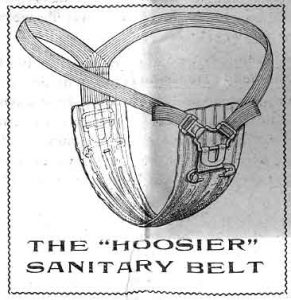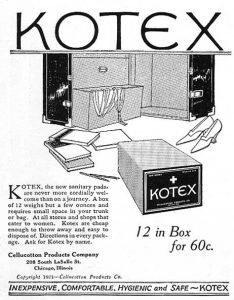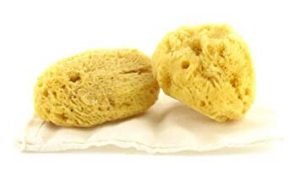How women have been tackling their menstrual cycles since the beginning of humanity has evolved incredibly. Starting with separation from society in many cultures during Biblical times, to bleeding onto rags or right on their clothes in Medieval times, and then to the development of the pad (1). During the 18th century the Hoosier Belt came into circulation, for sanitary reasons, with a attachable, washable pad. Disposable pads were not on the market until the 1920s when nurses during the war discovered that medical bandages also worked well with absorbing period blood (1). Up until the 1980s, when the Hoosier Belt was no longer in fashion, disposable menstrual products were leaking less, becoming more comfortable, and more popular (1). The alterations in period products gave women more freedom and comfort with a natural bodily function almost all women go through. With the rising concern of waste and sustainable development, menstrual products have been going through another recreation. These new innovations reduce the amount of waste produced during the week of a woman’s menstrual cycle while also giving her more freedom and something to feel good about. Some of the more sustainable options were created years ago but have been improved to fit women’s standards today.


On average, a woman will throw away between 10,000-15,000 pads and tampons in her life, which equates to 300 lbs of waste (4). One of the many environmental impacts attributed to the use of disposable feminine hygiene products, that many people overlook, is how they are created and what they are made of. For instance, a common chemical in plastic tampon applicators and the underside of stick-on pads is low-density polyethylene. This particular chemical requires a large amount of fossil fuel powered energy to create and results in a carbon footprint of 5.3 kg of CO2 (2). Now imagine that number but with all women around the world that have access to these products and the number of tampons and pads they will use in their lifetimes. In addition, it takes about 500-800 years for disposable feminine products to decompose (3), thus continually filling landfills. This is not sustainable because the life of the product after use is much longer than the woman who used it and that was only one napkin. Also, there are still many people who lack access to menstrual products and for period products to be sustainable they need to be inclusive and meet everyone’s needs no matter where they are. There are many companies who offer sustainable alternatives who also contribute to the fight of helping females in impoverished countries get access to products by donating their profits. Just another reason to buy them!

It may seem necessary to use disposable feminine products because that is what is advertised and primarily sold in stores, but it does not have to be that way. There are many comfortable alternatives to the menstrual products women are accustomed to today. There are menstrual cups, reusable pads and tampons, period underwear, sponges, and more sustainable, yet conventional products out there, like organic cotton pads and tampons. These products create less waste in landfills and are not created from chemicals harmful to the environment and to you. There is not that much information about menstruation due to the stigma that surrounds it, which hinders creative, sustainable innovations. in addition, many of the companies that oversee creating new period products for women do not want to pursue the sustainable route because it will decrease their sales and the dependence of women on their companies. The stigma and company power needs to change so that women can approach a natural occurrence in a more sustainable way that will also enhance future generations of females to have more power over their bodies and the impacts they have on their surrounding environment.



Here are the links to some sustainable menstrual products that supplies reviews, options, their missions, and why to make the switch.
- Diva Cup (menstrual cup): http://divacup.com/
- Lunapads (reusable pads): https://lunapads.com/
- Thinx (Period underwear): https://www.shethinx.com/
- Natracare (Organic pads/tampons): http://www.natracare.com/
Sources:
- https://www.medicaldaily.com/menstrual-period-time-month-history-387252
- https://rctom.hbs.org/submission/the-ecological-impact-of-feminine-hygiene-products/
- https://medium.com/one-future/sustainable-menstruation-the-environmental-impact-of-menstrual-products-eba30e095cda
- https://www.bustle.com/articles/129938-6-ways-to-be-environmentally-conscious-during-your-period
- Emilia Hyland